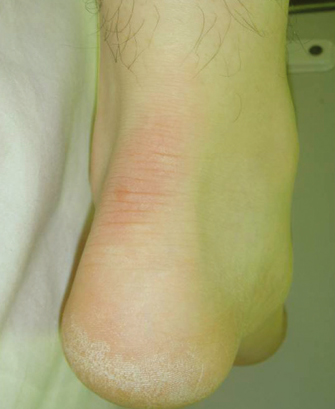Yonsei Med J.
2010 May;51(3):454-456. 10.3349/ymj.2010.51.3.454.
Levofloxacin-Induced Achilles Tendinitis in a Young Adult in the Absence of Predisposing Conditions
- Affiliations
-
- 1Department of Internal Medicine, Inha University School of Medicine, Incheon, Korea. ljinsoo@medimail.co.kr
- KMID: 1075001
- DOI: http://doi.org/10.3349/ymj.2010.51.3.454
Abstract
- Fluoroquinolones (FQs) represent a major class of antimicrobials that have a high potential as therapeutic agents. Although FQs are generally safe for the use as antimicrobials, they may induce tendinopathic complications such as tendinitis and tendon rupture. A number of factors have been suggested to further predispose a patient to such injuries. Hitherto, a few published cases on tendon disorders have implicated levofloxacin, a more recently introduced FQ. Here, we report a patient with levofloxacin-induced Achilles tendinitis, who exhibited no known predisposing factors. A 20-year-old man without any history of disease or medication presented with community-acquired pneumonia. Levofloxacin was administered and 3 days later, he complained of pain in the left Achilles tendon and revealed redness and swelling in the area. On suspecting Achilles tendinitis, levofloxacin treatment was discontinued, and the tendinitis subsequently improved. To our knowledge, this is the first case report on FQ-induced Achilles tendinitis in Korea.
MeSH Terms
Figure
Cited by 1 articles
-
Refractory Achilles Tendinopathy and Multiple Pain on the Tendon and Tendon Attachment Site of the Foot Related to Intermittent Levofloxacin Usage: A Case Report
Seung Jun Park, Jin Soo Suh, Jun Young Choi
J Korean Foot Ankle Soc. 2023;27(3):103-107. doi: 10.14193/jkfas.2023.27.3.103.
Reference
-
1. Takayama S, Hirohashi M, Kato M, Shimada H. Toxicity of quinolone antimicrobial agents. J Toxicol Environ Health. 1995. 45:1–45.
Article2. Bartlett JG, Dowell SF, Mandell LA, File TM Jr, Musher DM, Fine MJ. Infectious Diseases Society of America. Practice guidelines for the management of community-acquired pneumonia in adults. Clin Infect Dis. 2000. 31:347–382.
Article3. O'Donnell JA, Gelone SP. The newer fluoroquinolones. Infect Dis Clin North Am. 2004. 18:691–716. x.4. Lipsky BA, Baker CA. Fluoroquinolone toxicity profiles: a review focusing on newer agents. Clin Infect Dis. 1999. 28:352–364.
Article5. Kahn JB. Latest industry information on the safety profile of levofloxacin in the US. Chemotherapy. 2001. 47:Suppl 3. 32–37.
Article6. Lewis JR, Gums JG, Dickensheets DL. Levofloxacin-induced bilateral Achilles tendonitis. Ann Pharmacother. 1999. 33:792–795.
Article7. Khaliq Y, Zhanel GG. Fluoroquinolone-associated tendinopathy: a critical review of the literature. Clin Infect Dis. 2003. 36:1404–1410.
Article8. Corrao G, Zambon A, Bertù L, Mauri A, Paleari V, Rossi C, et al. Evidence of tendinitis provoked by fluoroquinolone treatment: a case-control study. Drug Saf. 2006. 29:889–896.9. van der Linden PD, van Puijenbroek EP, Feenstra J, Veld BA, Sturkenboom MC, Herings RM, et al. Tendon disorders attributed to fluoroquinolones: a study on 42 spontaneous reports in the period 1988 to 1998. Arthritis Rheum. 2001. 45:235–239.
Article10. Seeger JD, West WA, Fife D, Noel GJ, Johnson LN, Walker AM. Achilles tendon rupture and its association with fluoroquinolone antibiotics and other potential risk factors in a managed care population. Pharmacoepidemiol Drug Saf. 2006. 15:784–792.
Article11. Wilton LV, Pearce GL, Mann RD. A comparison of ciprofloxacin, norfloxacin, ofloxacin, azithromycin, and cefixime examined by observational cohort studies. Br J Clin Pharmacol. 1996. 41:277–284.
Article12. Lafon M. Tendinopathies et fluoroquinolones. Concours Med. 1993. 115:819–825.13. Domagala JM. Structure-activity and structure-side-effect relationships for the quinolone antibacterials. J Antimicrob Chemother. 1994. 33:685–706.14. Bailey RR, Kirk JA, Peddie BA. Norfloxacin-induced rheumatic disease. N Z Med J. 1983. 96:590.15. van der Linden PD, Sturkenboom MC, Herings RM, Leufkens HG, Stricker BH. Fluoroquinolones and risk of Achilles tendon disorders: case-control study. BMJ. 2002. 324:1306–1307.16. Fleisch F, Hartmann K, Kuhn M. Fluoroquinolone-induced tendinopathy: also occurring with levofloxacin. Infection. 2000. 28:256–257.17. Gillet P, Blum A, Hestin D, Pourel J, Pierfitte C, Mainard D, et al. Magnetic resonance imaging may be an asset to diagnose and classify fluoroquinolone-associated Achilles tendinitis. Fundam Clin Pharmacol. 1995. 9:52–56.
Article18. Burkhardt O, Köhnlein T, Pap T, Welte T. Recurrent tendinitis after treatment with two different fluoroquinolones. Scand J Infect Dis. 2004. 36:315–316.
Article19. Ball P. Adverse drug reactions: implications for the development of fluoroquinolones. J Antimicrob Chemother. 2003. 51:Suppl 1. 21–27.
Article
- Full Text Links
- Actions
-
Cited
- CITED
-
- Close
- Share
- Similar articles
-
- Surgical Treatment of Tuberculous Achilles Tendinitis: Case Report
- Etiology of Achilles Tendinopathy: Inflammation versus Overuse
- Clinical Utility of Radiographic Measurements of Insertional Achilles Tendinitis with Haglund's Deformity
- Refractory Achilles Tendinopathy and Multiple Pain on the Tendon and Tendon Attachment Site of the Foot Related to Intermittent Levofloxacin Usage: A Case Report
- Rupture of Achilles Tendon after Steroid Injection in Achilles Tendinitis (A Report of Five Cases)


